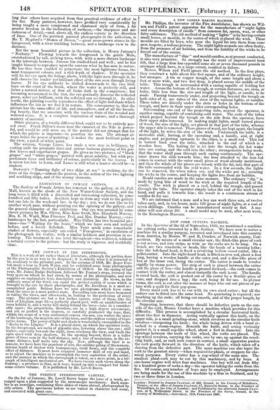A NEW CANDLE MAKING MACHINE.
Mr. Phillips, the inventor of the Fire Annihilator, has shown us Wil-
son and Field's patent apparatus for the manufacture of "night lights and every description of candle" from common fat, sperm, wax, or other fatty substance. The old method of making " lights ' is by having certain small boxes, or moulds, In the centre of which is placed the wick. These moulds are filled by hoys, who pour the liquid fat into them from com- mon teapots ; a tedious process. The night lights so made are often faulty, from the presence of air bubbles, and from the liability of the wicks to be forced out of the centre.
The manufacture of " dips " and mould candles, as at present conducted, is also very primitive. So strongly has the want of improvement been felt, that a large firm has expended some six or seven thousand pounds in .attempts which have, to a large extent, resulted in failure.
Messrs. Wilson and Field ignore the old method. In the first place, they construct a table about five feet square, and of the ordinary height, but stronger. A tin or copper trough, of the same length and about a foot or more wide, and two feet deep, is placed across the middle, of the table. This trough is surrounded with a casing capable of holding hot water. Across the bottom of the trough, at certain distances, are slots, or holes, little less than the size and length of the light, or candle, to be made. Passing transversely under, and projecting beyond the trough on both sides of it, are tubes of the sizes of the various lights, or candles. These tubes are directly under the slots or holes in the bottom of the trough, and have in their upper sides corresponding holes.
Surrounding one end of the projecting tube, nearest the operator, is another easing, capable of containing cold water. The ends of the tubes which project beyond the trough on the side from the operator, have their upper sides removed. In making night lights, small turned pieces of wood, the size of the light, are placed in that part of the tube, whence the upper side is removed. Those pieces of wood, are kept apart, the length of the light, by wires the size of the wick. Underneath the table, is a moveable slide, having, at the operating end, a handle, and, at right angles, and projecting upwards to the other, is a small rod. This rod is turned back over the table, attached to the end of which is a wooden boss. The boiling fat is let into the trough, the hot water into one casing, and the cold into the other ; arrangements being made, that the water shall pass through each casing continuously. The ope- rator draws the slide towards him ; the boss attached to the iron rod comes in contact with the outer small piece of wood already mentioned. and then the whole of the pieces are forced, with the fat, into that part of the tube surrounded with the cold water. In a few seconds, the lights can be removed, the wires taken out, and the wicks put in - securing the wicks in the centre, and keeping the lights free from air bubbles. Mould candles are made in the same manner. The ordinary "dip " is made by tying bits of wood to the wick at the required length of the candle. The wick is placed on a reel, behind the trough, and passed through the tube. The operator simply takes the end of the wick in his hand, and pulls it towards him ; the result is a continuous stream of candles fit for use.
We are informed that a man and a boy can work three sets, of twelve tubes each, and, in ten hours, make 120 gross of night lights, at a cost of seven shillings. Candles can be manufactured nearly as fast. A ma- chine will cost about 201. A small model may be seen, after next week, in the Kensington Museum.






























 Previous page
Previous page